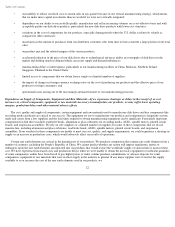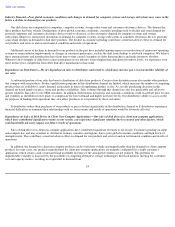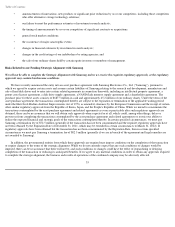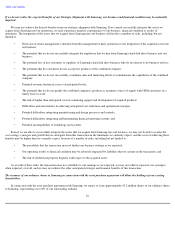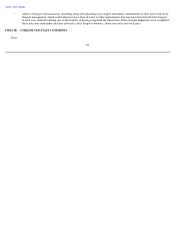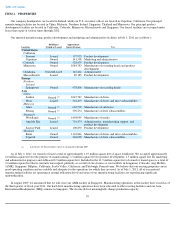Seagate 2010 Annual Report Download - page 32
Download and view the complete annual report
Please find page 32 of the 2010 Seagate annual report below. You can navigate through the pages in the report by either clicking on the pages listed below, or by using the keyword search tool below to find specific information within the annual report.
Table of Contents
In addition, some of the agreements governing our other debt instruments contain cross-
default provisions that may be triggered by a default
under our senior secured revolving credit facility. In the event that we default under our senior secured revolving credit facility, there could be an
event of default under cross-default provisions for the applicable debt instrument. As a result, all outstanding obligations under certain of our
debt instruments may become immediately due and payable. If such acceleration were to occur, we may not have adequate funds to satisfy all of
our outstanding obligations, the lenders could exercise their rights, as described above, and we could be forced into bankruptcy or liquidation.
Substantially all of our Assets are Pledged as Collateral to Secure Certain Indebtedness
—Since substantially all of our assets are used to
secure portions of our existing debt obligations, we may be limited in our ability to incur additional indebtedness or to provide additional
credit support, and if we fail to meet our payment or other obligations under certain of our existing debt obligations, the lenders thereunder
could foreclose on, and acquire control of, substantially all of our assets.
Substantially all our assets and the assets of our significant subsidiaries organized in the United States, the Cayman Islands, the
Netherlands, Northern Ireland and Singapore, as well as certain assets located in the United States, the Cayman Islands, the Netherlands,
Northern Ireland and Singapore owned by other significant subsidiaries, and all proceeds therefrom, are pledged as security for borrowings under
our 10% Notes, as well as obligations under our hedging agreements, cash management arrangements and certain metal leasing arrangements.
Since substantially all of our assets are used to secure portions of our existing debt obligations, we have a limited amount of collateral that is
available for future secured debt or credit support. As a result, we may be limited in our ability to incur additional indebtedness or to provide
additional credit support for our existing indebtedness. In addition, our failure to comply with the terms of the indenture governing our 10%
Notes would entitle the lenders thereunder to declare all funds borrowed thereunder to be immediately due and payable. If we were unable to
meet these payment obligations, the lenders could foreclose on, and acquire control of, substantially all our assets that serve as collateral.
Failure to Pay Quarterly Dividends—
Our failure to pay quarterly dividends to our shareholders could cause the market price of our ordinary
shares to decline significantly.
On April 7, 2011, we declared a dividend of $0.18 per share that was paid on June 1, 2011 to our shareholders of record as of May 2, 2011.
On July 20, 2011, the Board of Directors approved a cash dividend of $0.18 per share, which will be payable on August 26, 2011 to our
shareholders of record as of the close of business on August 5, 2011.
Our ability to pay quarterly dividends will be subject to, among other things, our financial position and results of operations, available cash
and cash flow, capital requirements, and other factors. Any reduction or discontinuation of quarterly dividends could cause the market price of
our ordinary shares to decline significantly. Moreover, in the event our payment of quarterly dividends is reduced or discontinued, our failure or
inability to resume paying dividends at historical levels could result in a persistently low market valuation of our ordinary shares.
Purchase Commitments to Certain Suppliers
—If revenues fall or customer demand decreases significantly, we may not meet all of our
purchase commitments to certain suppliers.
From time to time, we enter into long-term, non-cancelable purchase commitments with certain suppliers in order to secure certain
components for the production of our products or to supplement our internal manufacturing capacity for certain components. If our actual
revenues in the future are lower than our projections or if customer demand decreases significantly below our projections, we may not meet all
of our purchase commitments with these suppliers. As a result, it is possible that we will have to shift output from our internal manufacturing
facilities to these suppliers or make penalty-type payments under these contracts.
29





